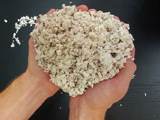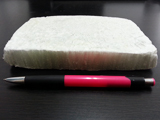Manufacturing of sustainable insulating boards made of nano-cellulose
BRIMEE EU project started
Old buildings quite often consume a lot of energy because they are badly insulated or not insulated at all. A solution may be provided by insulating boards that are attached to the exterior and interior facade of the building via a cladding system. Such insulating boards are exactly what is to be developed in the BRIMEE EU project: in efficient process chains and sustainably nano crystalline cellulose (NCC) is extracted from residuals of pulp and paper processing. Fraunhofer UMSICHT is contributing to this project its process engineering expertise in the area of scaling-up the insulating board manufacturing.


In most countries, buildings are responsible for at least 40 percent of the primary energy consumption, according to the World Business Council for Sustainable Development WBCSD. In Europe, approx. 10 million multi-family homes built before 1975 have an energy consumption that is too high. As part of a Europe-wide building sanitation, the EU Commission wants to modernize this pool of buildings by 2050 to be more climate-friendly. In this context, the BRIMEE EU project ("Cost-effective and sustainable Bio-Renewable Indoor Materials with high potential for customization and creative design in Energy Efficient buildings") is intended to help achieve the objective of the European Directive on the Energy Performance of Building (EPBD). Insulating boards are to be developed that can be installed on the building facade as cladding – both on the inside and on the outside. The great thing about the project’s approach: paper waste will be utilized in the manufacturing of the insulating foam.
Sustainably utilizing waste products
Each year, approx. 11 million tons of sludge derived from pulp and paper processing are to be managed as waste in Europe. In the BRIMEE project, this paper fiber sludge is the key raw material for manufacturing insulating foam. The method for the chemical/mechanical pre-treatment and further processing of the paper fiber sludge was developed at the Hebrew University of Jerusalem and Melodea Ltd. in Israel, explains Dr. Stephan Kabasci, project manager at Fraunhofer UMSICHT: "Through the pre-treatment, a jelly-like suspension of nano-crystalline cellulose (NCC) is created. In this process step, various additives can furthermore be introduced in a targeted manner, e.g. for fire-proofing or to increase stability." Subsequently, the cellulose pulp is poured into a mold, frozen, dehydrated, and processed into finished insulating elements. "Using this process at pilot scale Melodea can already create foam boards having the size of postcards. An essential task of the BRIMEE project is the scale-up of the manufacturing process to a larger size. In the future, we want to be able to offer the construction industry insulating foam boards that have a size of at least 50 x 100 centimeters", explained Kabasci, who is in head of the Bio-based Plastics department at Fraunhofer UMSICHT.
Energy-saving process chain
In the scale-up of the manufacturing process, Fraunhofer UMSICHT is contributing its process engineering expertise. "Our objective is to implement a process that is as energy-saving as possible, in which all materials utilized are recycled as completely as possible, and that guarantees a reproducible board production", said Kabasci. This way, a process at a pre-industrial scale is to be created for the insulating board production.
Modular system to allow for building restoration of old buildings
The insulating panels themselves are developed by other project partners such that they can be utilized in the form of a cladding system. "Since the insulating panels are to be designed in a modular system, they are particularly well suited for the restoration of old buildings", explains Stephan Kabasci. "With the components made of NCC, we want to make possible both the exterior and interior insulation of buildings in an easy, flexible and sturdy way." The objective of the last project phase is the complete production of the first insulating boards at pre-industrial scale and their test in practice at two buildings in Spain and in the Czech Republic.
The BRIMEE EU project, with 14 project partners from Europe and Israel covering research, industry and architecture, started on 1 July 2013 for four years duration and receives funding from the European Union Seventh Framework Programme FP7/2007-2013 under grant agreement n° 608910. From Germany, in addition to Fraunhofer UMSICHT, the Federal Institute for Materials Research and Testing (BAM - Bundesanstalt für Materialforschung und -prüfung) is participating.
Partners in the BRIMEE consortium
D'APPOLONIA SPA, Italy
DRAGADOS SA, Spain
BERGAMO TECNOLOGIE SPZOO BG TECNO, Poland
BUILDING RESEARCH ESTABLISHMENT LTD BRE, United Kingdom
BUNDESANSTALT FUER MATERIALFORSCHUNG UND -PRUEFUNG BAM, Germany
MELODEA LTD, Israel
ZAVOD ZA GRADBENISTVO SLOVENIJE, Slovenia
PROIGMENES EREVNITIKES & DIAHIRISTIKES EFARMOGES, Greece
FRAUNHOFER-GESELLSCHAFT, Germany
THE HEBREW UNIVERSITY OF JERUSALEM, Israel
BRZOZOWSKI GRABOWIECKI ARCHITEKCI SP. Z O. O., Poland
SILCART SPA, Italy
FENIX TNT SRO, Czech Republic
INSTITUTUL DE CERCETARI ELECTROTEHNICE, Romania
 Fraunhofer Institute for Environmental, Safety and Energy Technology UMSICHT
Fraunhofer Institute for Environmental, Safety and Energy Technology UMSICHT